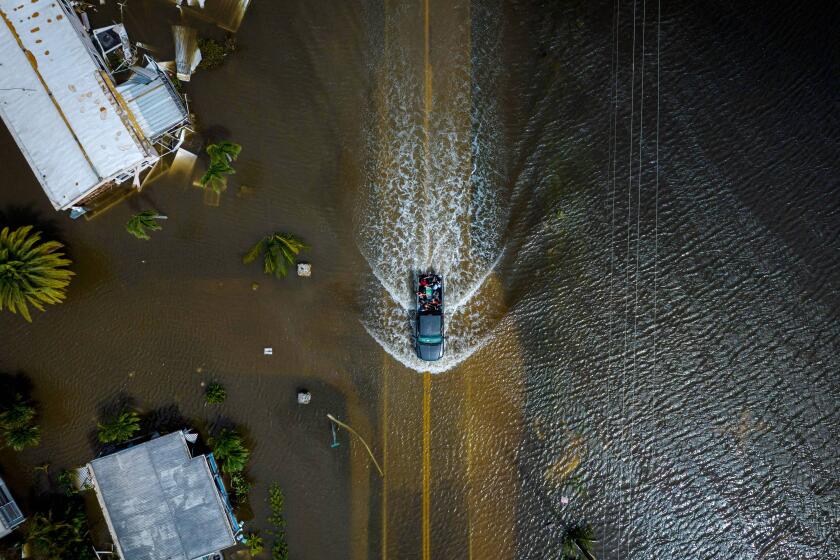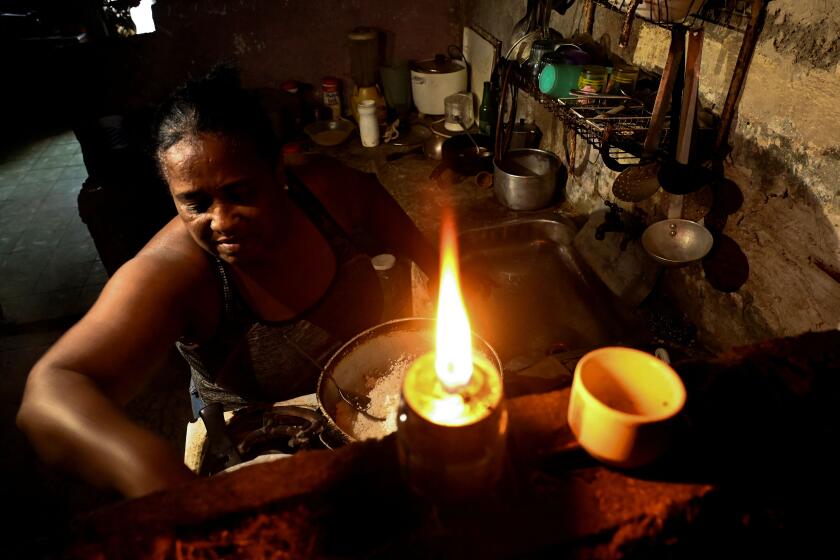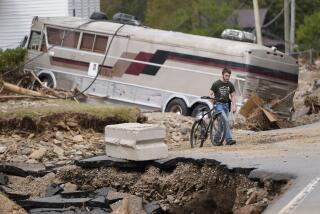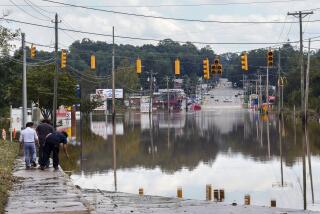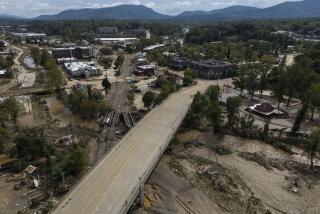Ian leaves dozens dead and rescuers searching flooded Florida homes for survivors
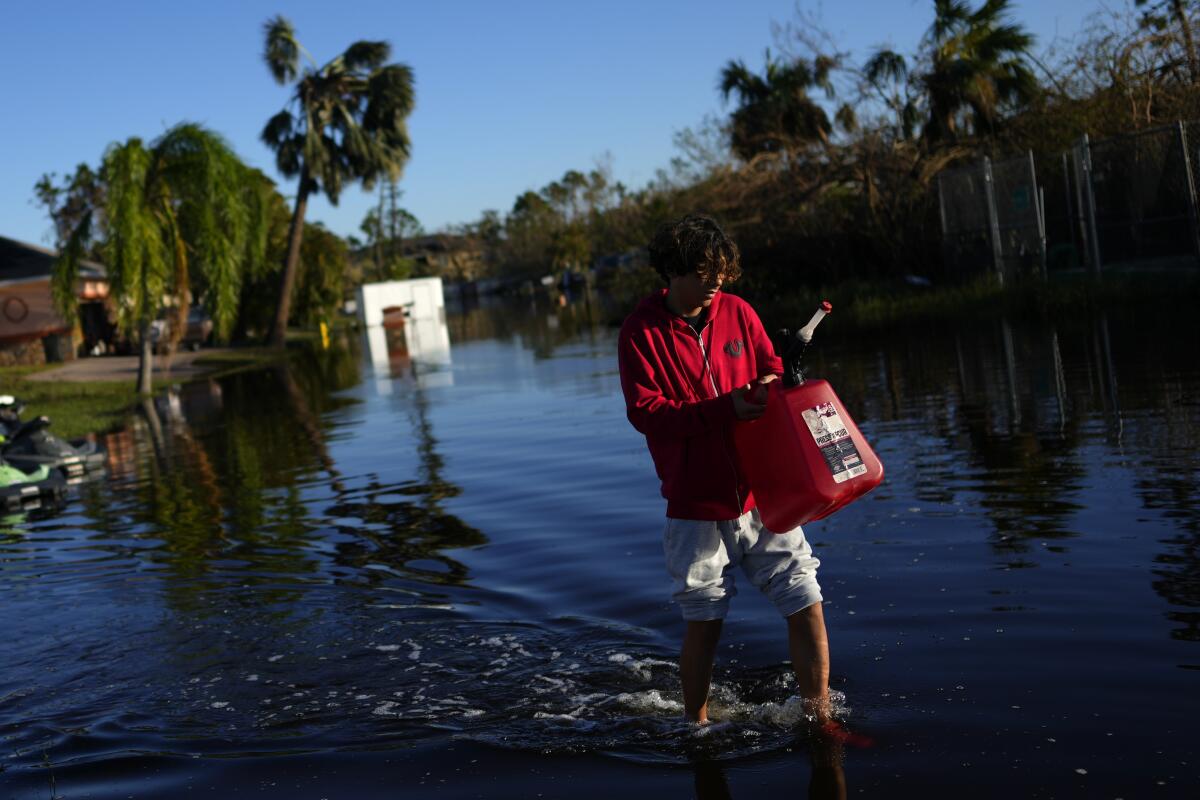
- Share via
FORT MYERS, Fla. — Dozens of Florida residents left their flooded and splintered homes by boat and by air on Saturday as rescuers continued to search for survivors following Hurricane Ian, while authorities in South Carolina and North Carolina began taking stock of their losses.
The death toll from the storm, one of the strongest hurricanes by wind speed to ever hit the U.S., grew to more than four dozen, with 47 deaths confirmed in Florida, four in North Carolina and three deaths in Cuba.
The storm weakened Saturday as it rolled into the mid-Atlantic, but not before it washed out bridges and piers, hurled massive boats into buildings, sheared off roofs and left hundreds of thousands without power.
Most of the deaths were from drowning, but others were due to Ian’s aftereffects. One elderly couple died after their oxygen machines shut off when they lost power, authorities said.
As of Saturday, more than 1,000 people had been rescued from flooded areas along Florida’s southwestern coast, Gen. Daniel Hokanson, head of the National Guard, told the Associated Press while airborne to Florida.
Chris Schnapp was at the Port Sanibel Marina in Fort Myers on Saturday, waiting to see whether her 83-year-old mother-in-law had been evacuated from Sanibel Island. A pontoon boat had just arrived with a load of passengers from the island — with suitcases and animals in tow — but Schnapp’s mother-in-law was not among them.
“She stayed on the island. My brother-in-law and sister-in-law own two businesses over there. They evacuated. She did not want to go,” Schnapp said. She wasn’t sure whether her mother-in-law was still on the island or had been taken to a shelter elsewhere.
A revived Hurricane Ian pounded South Carolina on Friday after causing catastrophic damage in Florida and leaving at least 17 people dead.
On Pine Island, the largest barrier island off Florida’s Gulf Coast, houses were reduced to splinters and boats littered roadways. A volunteer group went door-to-door Saturday, asking residents whether they wanted to be evacuated. Helen Koch blew her husband a kiss and mouthed, “I love you” as she sat inside a rescue helicopter that was lifting her and seven of the couple’s 17 dogs to safety.
River flooding posed a major challenge at times to rescue and supply delivery efforts. The Myakka River washed over a stretch of Interstate 75, temporarily closing the key corridor between Tampa and the hard-hit area straddling Port Charlotte and Fort Myers. Later Saturday, state officials said, water levels had receded enough that I-75 could be fully reopened. However, they said monitors were keeping close watch on constantly changing river levels.
Rising waters in Florida’s southwest rivers had crested or were near cresting Saturday, and the levels weren’t expected to drop significantly for days, said National Weather Service meteorologist Tyler Fleming in Tampa.
In South Carolina, Pawleys Island — a beach community roughly 75 miles up the coast from Charleston — was among the places hit hardest. At least half of the barrier island remained without power Saturday.
Eddie Wilder, who has been coming to Pawleys Island for over six decades, said Friday’s storm was “insane to watch.” He said waves as high as 25 feet washed away the landmark pier near his home.
“We watched it hit the pier and saw the pier disappear,” said Wilder, whose house 30 feet above sea level stayed dry inside. “We watched it crumble and watched it float by with an American flag.”
Hurricane Ian made landfall in southwest Florida on Wednesday as a catastrophic Category 4 storm.
The Pawleys Island pier was one of at least four along South Carolina’s coast that were destroyed by Ian’s battering winds and rain. Parts of the pier, including barnacle-covered pylons, littered the beach. The intracoastal waterway was strewn with the remnants of several boat houses that were knocked off their pilings.
John Joseph said he was elated Saturday to return from nearby Georgetown, which had taken a direct hit. His family’s Pawleys Island beach home, which his father built in 1962, remained intact.
“Thank God these walls are still here, and we feel very blessed that this is the worst thing,” he said of the sand that swept under his home. “What happened in Florida — gosh, God bless us. If we’d had a Category 4, I wouldn’t be here.“
In North Carolina, the storm claimed four lives and downed trees and power lines, leaving over 280,000 customers statewide without power Saturday morning, officials said. Two of the deaths were from storm-related vehicle crashes; one man drowned when his truck plunged into a swamp; and another man was killed by carbon monoxide poisoning from a generator in a garage, officials said.
In southwest Florida, authorities and volunteers were still assessing the damage as shocked residents tried to make sense of the disaster.
“I want to sit in the corner and cry. I don’t know what else to do,” Stevie Scuderi said after shuffling through her mostly destroyed Fort Myers apartment, with mud from her kitchen still clinging to her purple sandals.
On Saturday, a long line of people waited outside an O’Reilly Auto Parts store in Port Charlotte, where a sign read, “We have generators now.” Hundreds of cars were lined up outside a Wawa gas station, and people carried gas cans to their nearby cars.
Hundreds of Cubans have taken to the streets in Havana demanding the restoration of electricity.
At Port Sanibel Marina in Fort Myers, charter boat captain Ryan Kane was assessing damage to two boats Saturday from the storm surge that had pushed several boats and a dock onto shore. He said the boat he owns was totaled, so he couldn’t use it to help rescue people, and it would be a long time before he’d be chartering fishing clients.
“There’s a hole in the hull. It took water in the motors. It took water in everything,” he said, adding: “You know, boats are supposed to be in the water, not in parking lots.”
Kinnard reported from Pawleys Island, S.C.; Associated Press contributors include Anthony Izaguirre in Tallahassee, Fla.; Terry Spencer and Tim Reynolds in Fort Myers, Fla.; Cody Jackson in Tampa, Fla.; Freida Frisaro in Miami; Mike Schneider in Orlando, Fla.; Daniel Kozin in North Port, Fla.; Seth Borenstein in Washington; Bobby Caina Calvan in New York; and Jeffrey Collins in Columbia, S.C.
More to Read
Sign up for Essential California
The most important California stories and recommendations in your inbox every morning.
You may occasionally receive promotional content from the Los Angeles Times.

